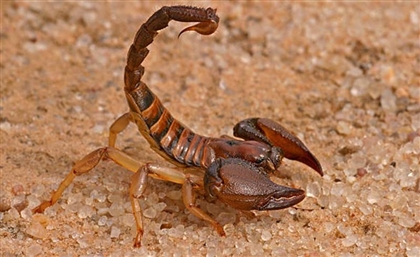A Day in the Life of an Egyptian Snake Wrangler
In the Refaey family’s world, their clients’ bite is far louder than their bark.
Let’s say that nine out of ten times, hearing the name “Abu Rawash” would only evoke painful memories of your periodic car maintenance. But you’d be hard-pressed to imagine the lush farmland, salt-of-the-earth farmers, and the indigenous wildlife that inhabits this little slice of Giza. But walk inside the villages of Abu Rawash, and you’ll find that depictions of snakes slowly slither into your periphery, painted over the doors of its homes.
Inside one such home lives a family unlike most, whose ranks include a 1.5-metre-long snake, dancing in the hands of a child no taller than 70 centimetres, as if it’s a toy. If there was ever a better jumping off point for our topic, it would be this exact scene.
The Family Trade
The Refaey family has been in the wrangling business for as long as they could remember, and includes both young and old members. Helmed by their father Ahmed Rashed El-Refaey, the family makes a living off of catching snakes, birds of prey, various reptiles and even arachnids.
“My name is Ahmed El-Refaey. I’m 32-years-old, and this has been my profession since I was born,” Ahmed didn’t have much of a say in what he’d grow up to be; he found himself in this line of work at a significantly young age. “My father wanted to steel my nerves as a child, and to do acclimate me to the job, he’d make me handle small, non-venomous snakes. In time, I learned to go out into the desert or farmlands to catch the prey I was tasked with. I grew to like it, and after a while, I left school after my 9th year.”
Tending to the Flock
If you were to house an animal of any sort, you’d do well to tend to its many needs if you wanted it to survive and prosper. You’d have to feed it when it’s hungry, provide it with water, care for its health and even tend to its sleeping patterns. But that’s all assuming that the animal in question can, in one way or another, express itself.
How do you do all that with a snake? They’re not exactly the most expressive sort. “It’s hard enough to figure out what animals want when they talk, and in the case of a snake, you have to pay immense attention to its subtle gestures, and its needs. You have to give it the food it likes and needs, you have to bathe it every single day, and if it’s not from around these parts, you have to adjust the temperature where it is to match where it came from. Otherwise, it won’t live long.”In his courtyard, Ahmed stands holding a calm, docile cobra in his hand. He helps it shed its skin (or molt) as he tells us more about tending to a snake’s needs. “A snake has to have a good meal every four or five days, and every three meals or roughly 15 days, it needs to shed its old skin, as if it’s putting on a new outfit.”
Ahmed’s favourite variety of Egyptian snake is the Boa, seeing as “you can catch one when it’s about 40 centimetres, and after watching it constrict and feed on chicks and quails, you can see it grow to 50 metres in length.”
Scaly Sentiments
It's probably inevitable to form some sort of a deep connection to any animal that you care for on a regular basis, and - surprisingly - snakes are no different. “I had a pair of snakes measuring in at about five and a half metres, but unfortunately, they passed away, and I was heartbroken because I’d spent so much time with them. After I’d dissected them, I found out that their livers had suffered damage, and I spent a good while trying to figure out what it was.”It’s safe to say that veterinary medicine in Egypt hasn’t really made many leaps or bounds when it comes to pets. Couple that with a general lack of knowledge when it comes to reptiles, and you can understand how vehement Ahmed is about finding his own solutions. “You have to keep looking for solutions to a snake’s health problems. If one of them came down with a cold, I’d give them human medication, failing that, I’ll give them antibiotics, and I’d keep trying to get to a solution regardless.”
What to Do After a Bite
If you were ever bitten by a venomous animal, you can find the necessary serums you need at Egypt’s Poison and Venom Centres. Problem is, they’re few and far between in Egypt’s hospitals, and the most memorable example would have to be the Demerdash hospital. “I can figure out if a snake is venomous by just looking at it, and that’s something I have to do pretty quickly; if it were to bite me way out in the middle of nowhere, I’d die before even getting close to a hospital.”
Living in a house with 5 or 6 massive snakes is not exactly safe living conditions, each one capable of crushing their prey with their bodies to devour them, or spitting their venom just about anywhere. There’s a level of caution to be taken at all times in that scenario, right down to your boring old cup of tea. “My father taught me a survival trick growing up; you have to boil your tea, and make sure it foams when you pour it. If it doesn’t foam, then the glass is either unclean, or it has venom in it.”In his 32 years of life, Ahmed has only been stung once, and not by a snake either, but a scorpion. As luck would have it, Ahmed fell victim to another scorpion sting while shooting with us.
“When a scorpion stings me, I tie off the affected area to trap the blood, and if a glass were available, I’d cup the area to drain the infected blood. If it were a snake bite, I’d just eat two or three onions and call it a day.” This was all demonstrated to us when a venomous scorpion had stung Ahmed while filming the video; he tied the area with the wound off, and shrugged off the pain to continue with us normally. He was expecting to get a temperature or even get a bit winded, but he told us that “after a sting, any affliction, disease or virus in my body wouldn’t be very effective, seeing as the immune system builds defenses after the first exposure.”
Where From? Where to?
Egypt has about 38 varieties of snakes, eight of which are venomous, and because Egypt is split between Africa and Asia, its snakes have the same divergence. “A skilled wrangler can easily tell what’s venomous and what isn’t, and according to what I’m on the hunt for, I set out for their regular habitats. After I figure out what lives where, I reposition some of the snakes to be somewhat nearby, so that I don’t have to trek too far deep, and so I have less of a risk of dying if I was stung.”
Ahmed can disappear for days, weeks and even months on any given hunt. “So long as I have a trip, I have my work cut out for me, and I can be gone for a while. I pick up a snake’s tracks and set out to find it, and when I reach its lair, I dig it up and grab it. If I can’t go about it the old-fashioned way, I get a sack and keep it open on one end over the hole, and I leave it there overnight. I come in the next day and find the snake in my trap.”
“When it comes to Egyptian snakes, we send them straight to the Serum and Vaccine Department. Rats and mice are sent to pharmacy and science universities, or really anybody who needs them for learning purposes.”
As for the larger snakes Ahmed catches, photographers and big name movie stars like Mohamed Ramadan usually have need of them for shoots, and they bring them back once they’re done. Sometimes, they want to keep them for good, a scenario Ahmed primes his snakes for. “We train our snakes not to constrict or try to hurt anybody, and photographers buy them for shooting purposes with people on beaches or studios, it’s a business I suppose.”
Like Father, Like Children
The entire Refaey family tree is in the wrangling business, whether it’s snakes, birds or any other creepy crawly. “We teach our kids at a young age how to hold a snake, how to steel their hearts and how to stay calm under pressure, be they girls or boys. In time, they learn to love the job, and they’re free to leave their education if it brings in enough ends meet. I do not force them into it whatsoever; if a child enjoys educations, they’ll keep at it. But if they enjoy wrangling, they’ll jump out at grade 9, just like me.”“That guy’s blessed” is the most common phrase that people throw at somebody who survives no matter how often they get stung or bitten, as if snakes can’t even bite them. “There’s no blessing involved with the business, we work under threat of death day in day out.”
Original Article by Nancy Fares
Translated by Ahmed Ikram
Photography by Ashraf Hamed
Shoot by @Mo4Network’s #MO4Productions
























